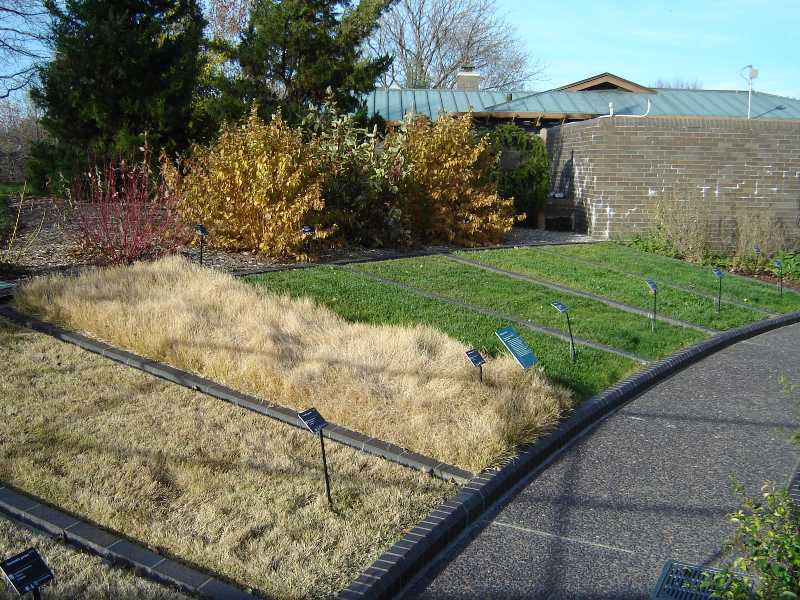
Grass plots in early November:
From left warm-season grasses (zoysia and buffalograss) then cool-season grasses (tall fescues) |
What are warm-season grasses?
Zoysia grass is the warm-season grass of choice for the St. Louis area.Other warm-season grasses include buffalo grass, Bermuda grass and bent grass. They grow best in the heat of summer and are dormant (turn brown) mid-October to mid- to late-May. Cool-season grasses (fine fescues, tall fescues, Kentucky bluegrass, and perennial ryegrass) grow best in the moderate temperatures of spring and fall and slow down or may go dormant (turn brown) in summer in the St. Louis area.
See “How do I grow a zoysia grass lawn?” and “Is buffalo grass a good lawn grass?” Or for fescue or Kentucky bluegrass lawns, see “Lawn Problems:Cool-season Grasses.” |
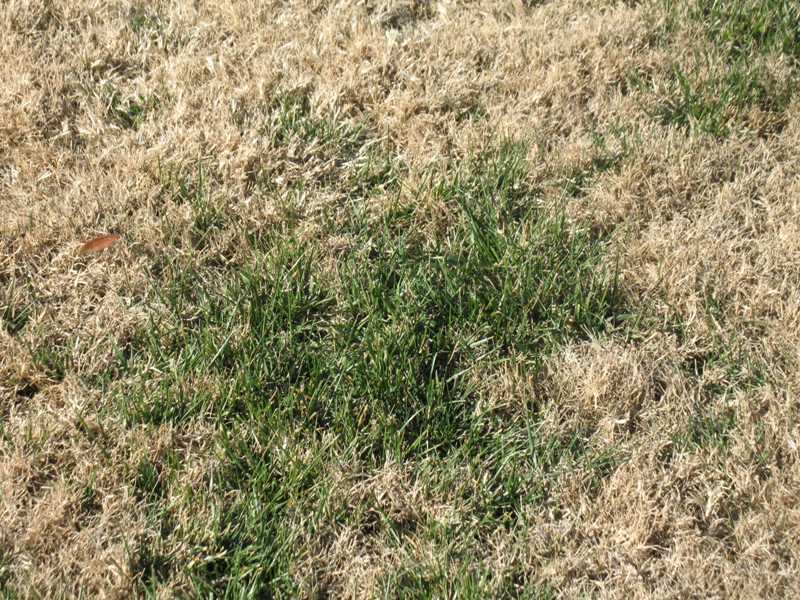
Tall fescue growing in a dormant zoysia lawn |
Cool-season grass growing in a zoysia grass lawn
Cool-season grasses, such as, tall fescue and Kentucky bluegrass, can invade zoysia grass lawns. These grasses are most evident from fall through late spring when they appear as green patches in an otherwise tan (dormant) zoysia grass lawn. When zoysia grass greens up, these patches are less noticeable. They may also appear as brown patches of dormant grass in heat and drought during summer. Invading cool-season grasses are usually more of a problem in poorly managed zoysia grass lawns, especially those that are fertilized when cool-season grasses like to be fertilized (in the fall) instead of when zoysia grass likes to be fertilized (in the summer).
See the information on perennial weeds in “How do I rejuvenate or repair dead spots in my zoysia grass lawn?” |
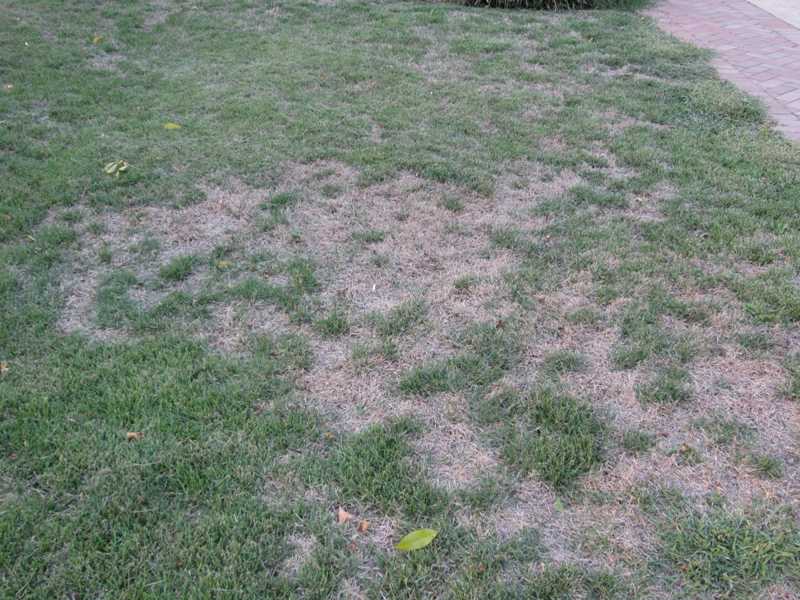
Patches of zoysia grass dying due to heat and drought stress |
Heat and drought stress
Although zoysia grass is more tolerant of heat and drought than any of the cool-season grasses, in severe heat and drought it may go dormant or die. Dormant lawns green-up when environmental conditions improve. Irrigated lawns are less apt to go dormant but run the increased risk of disease and insect problems. Zoysia grass requires about ½ inch of water per week to remain green and about ¼ inch of water per week to stay alive in dormancy.
See “Drought and Water Stress” and “When and how should I water my zoysia grass lawn?” |
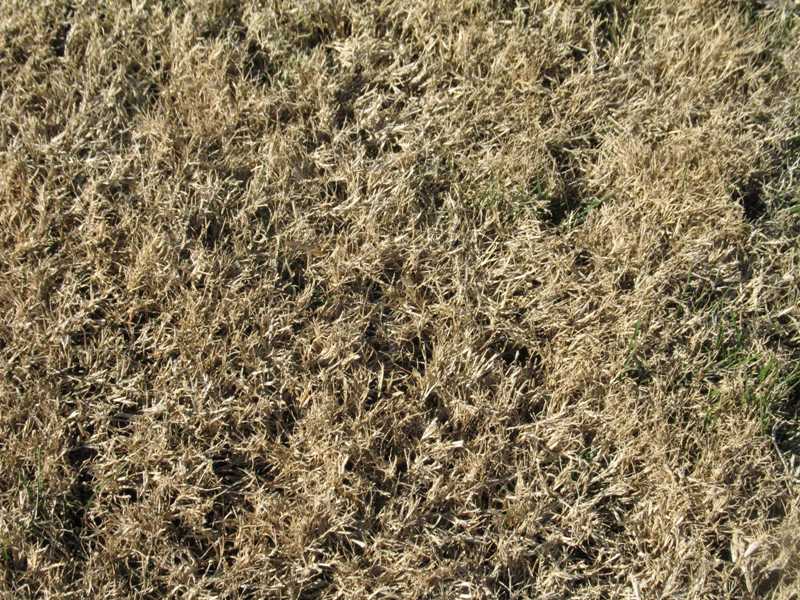
Dormant zoysia grass |
Is it dead or just dormant?
In the St. Louis area zoysia grass turns tan or brown in the fall and does not green up until spring (usually late May). Although it is heat and drought tolerant, it can go dormant or die during extreme heat or drought, especially when the two are combined. Determining if a patch of grass is dead or just dormant can be difficult. A close examination is required. Dormant grass will be firm at the base and resist a gentle tug. Dead grass will be shriveled with dead roots. It can be uprooted easily and will have dead, non-functioning roots. Dormant grass can resume growth; dead will not. |
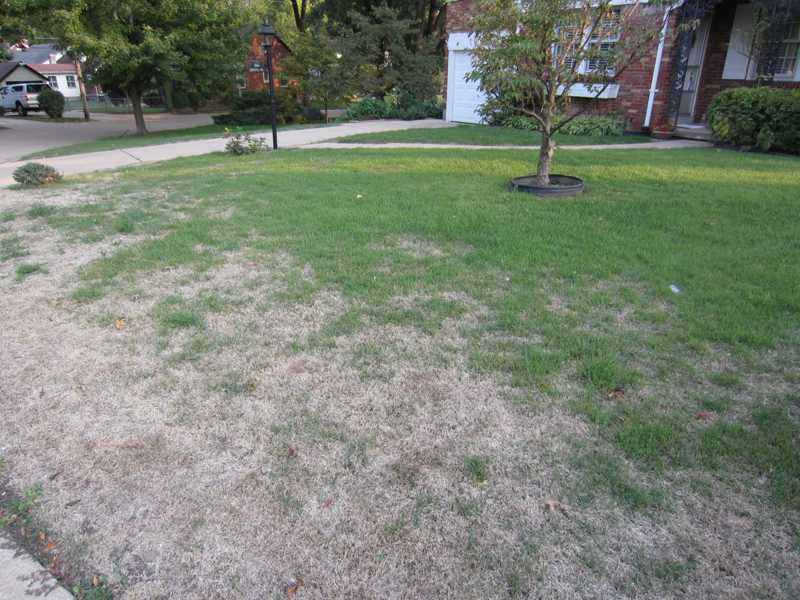
Slopes especially tbose near sidewalks and driveways can be difficult areas to water |
Dry slopes
Sunny, south or west-facing slopes are difficult locations for all grasses. These sites are also difficult to irrigate. Long, slow watering is needed to facilitate water uptake and prevent runoff. More frequent watering is needed in the heat of summer. |
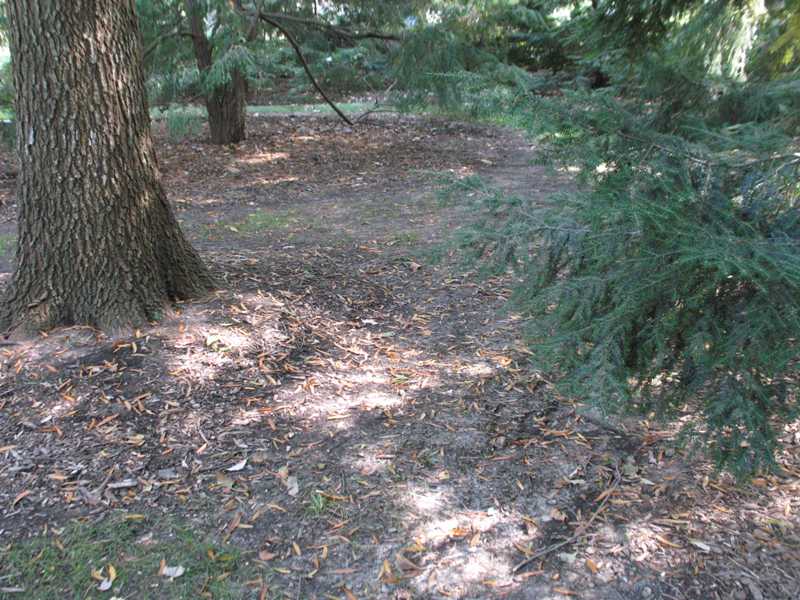
Very thin grass in dense shade
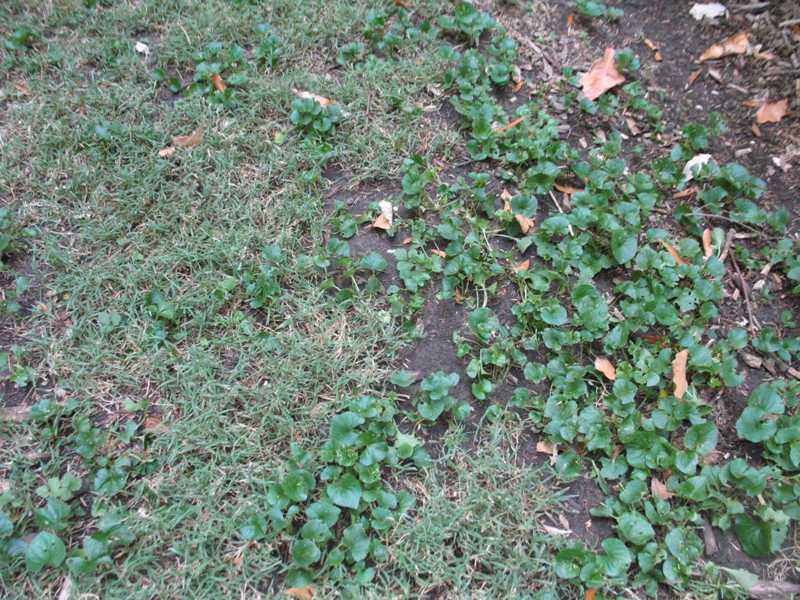
Nimblewill and violets growing in deep shade where lawn grasses struggle |
Shade and tree competition
Zoysia grass will only tolerate lightly shaded areas. It is virtually impossible to grow it, or any other lawn grass, in a heavily shaded area. Grass growing in shade under or close to trees can experience tremendous competition for ample light and moisture. It will be thin and never as lush and green as grass growing in full sun. Some grasses, such as the fine fescues (red, hard, sheep, spreading, creeping and chewing), are more tolerant of shade, but may still be unable to compete against tough, shade-loving weeds, such as, violets and nimblewill, especially in deep shade. Watering can help the dry situation but wet conditions can result in increased disease problems, such as, necrotic ring spot or pythium blight.
See “What lawn grasses will grow in the shade?” |
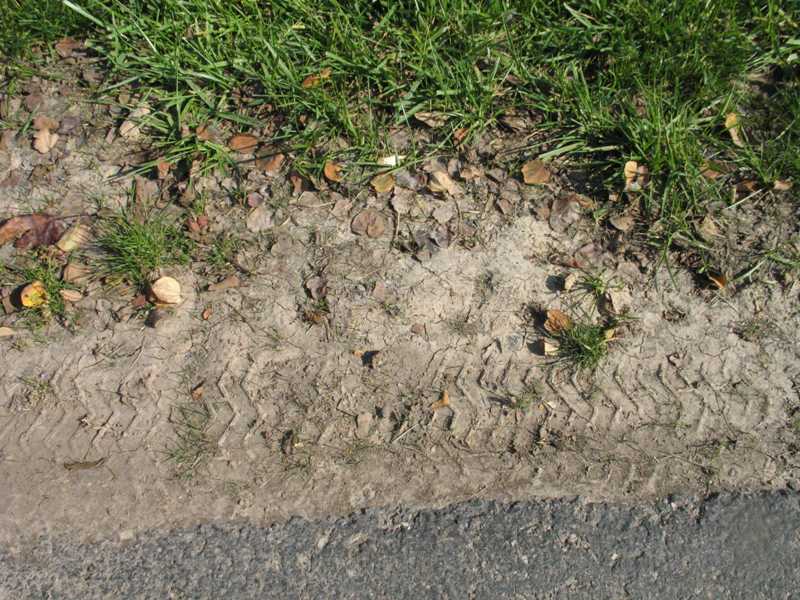
Note tire tracks |
Compaction
Grass will not grow well in soil that has been compacted by vehicles or foot traffic. Small areas can be dug with a spading fork or rototilled to a depth of 8-10 inches to loosen the soil. Large areas of zoysia grass or the entire lawn can be core aerified in late May or early June to help alleviate compaction and then plugged or sodded at the proper time (late May to early June in the St. Louis area).
See "What is core aerification and when should I do it?" |
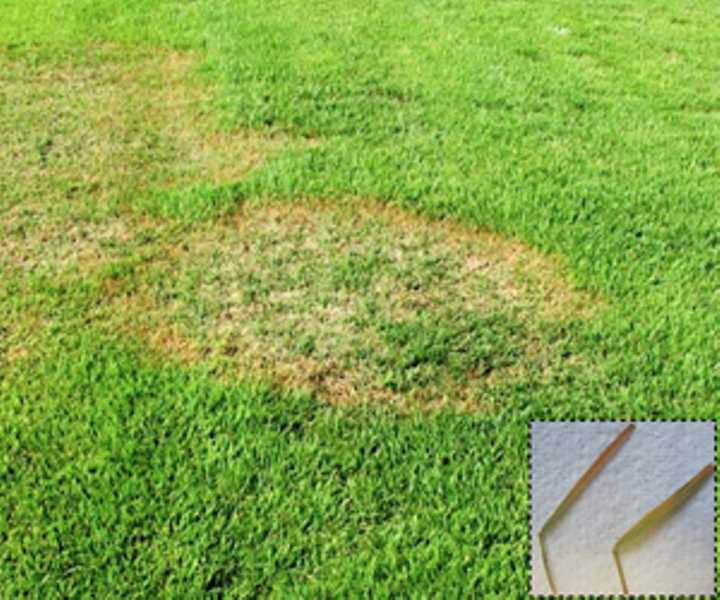
Large patch |
Fungal Diseases
Zoysia grass is susceptible to a number of fungal diseases. The most common is large brown patch, which begins as small circular patches of brown, lifeless grass that can enlarge and join together. Most fungal diseases exhibit distinctive patterns in the lawn or spots (lesions) on the leaf blades that aid in their identification. A very close examination of dying (not dead!) leaf blades is needed to verify which, if any, disease is present.
Diseases occur when very specific environmental conditions of temperature and moisture are present. Many diseases run their course before a homeowner can act, making the application of a fungicide of little or no value. Changes in environmental conditions or management practices can also halt a disease.
Lookalikes: Drought, chinch bugs, hunting billbugs, and nearly all the problems listed in this guide
See “What leaf diseases affect lawns in this area?” and “Fungal Diseases of Lawns” and “Large Brown Patch of Zoysia Lawns” |
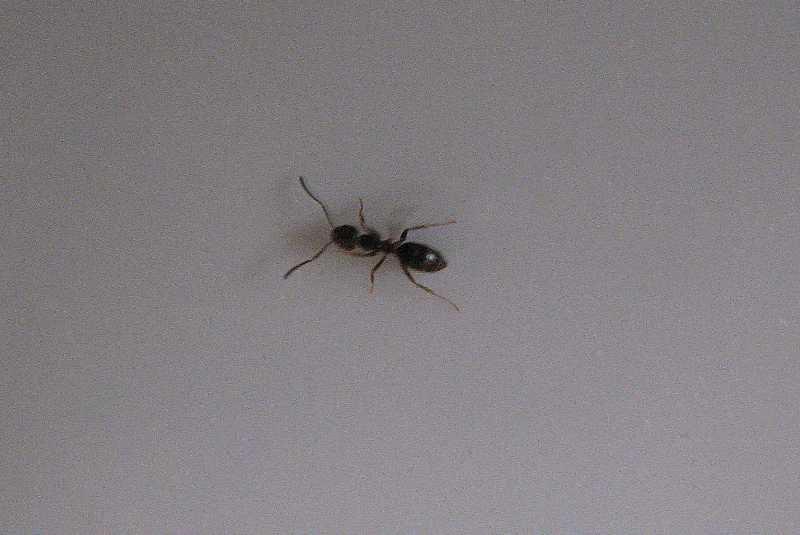
Ants aerate the soil and break down organic matter
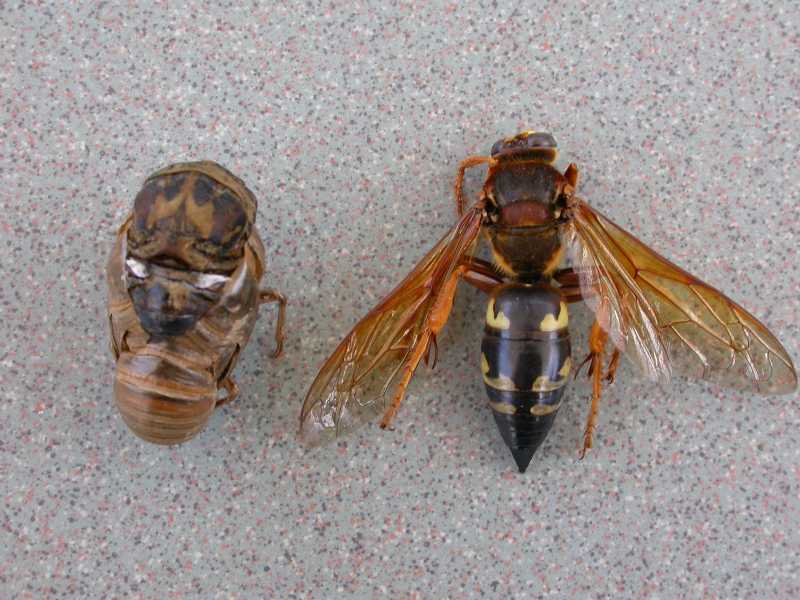
Cicada on the left, cicada killer wasp on the right. As ground dwelling insects, both are harmless |
Insects
Feeding activity of certain insects, such as, grubs (see below), can cause dead areas in lawns. Holes or scratched or torn areas of turf can be the result of birds and other animals scavenging for insects in the soil. Most problem insects are large enough to be seen and identified with a close, proper, and thorough examination. Get down on your hands and knees and look closely, keeping in mind that healthy soils contain many harmless or beneficial insects that should not be killed.
See “How can I check for insects in my lawn?” and “What insects are problems with zoysia grass lawns in this area?” and “Insects”. |
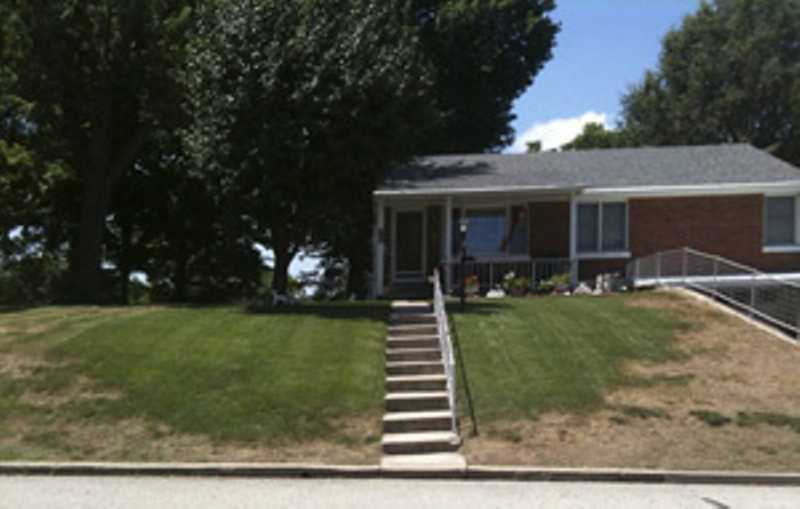
|
Chinch bugs
Chinch bugs (Blissus spp.) are the most damaging insect pest in zoysia grass. Unlike large patch, chinch bug damage occurs in the hot, dry summer months and most closely resembles drought damage. Affected areas are solid, not patchy, and will usually start on one side of the lawn and progress throughout as the chinch bug population builds and moves. Damage is most severe along lawn boundaries, particularly concrete driveways and sidewalks. The easiest method to detect chinch bug damage is to pull up damaged zoysia grass along these boundaries and look for the scattering, fast-moving, small (3/16-inch) black bugs. If chinch bugs are present, there is no recourse but the use of a curative insecticide to eliminate the problem. Because occurrence is sporadic from year to year, preventive insecticide applications targeted for chinch bugs are not recommended in this area.
Lookalikes: Drought, grubs (see below), hunting billbugs (see below)
See “How do I check for insects in my lawn?” and “Chinch bugs.” |
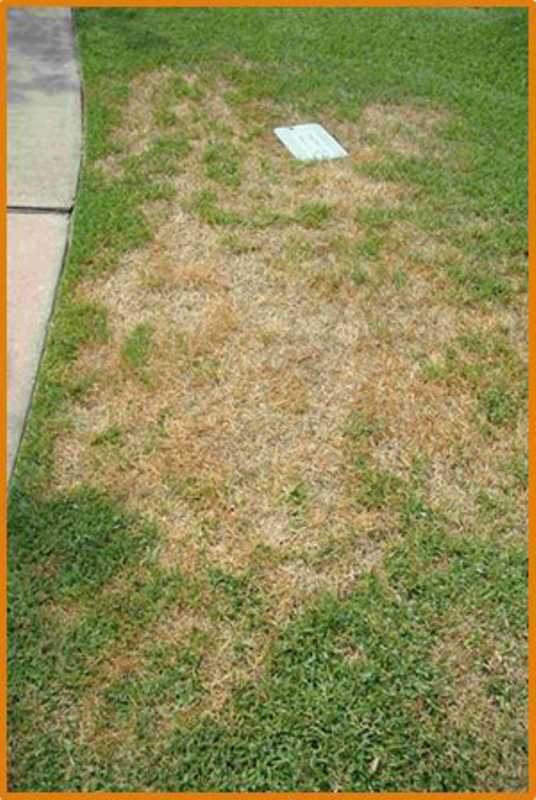
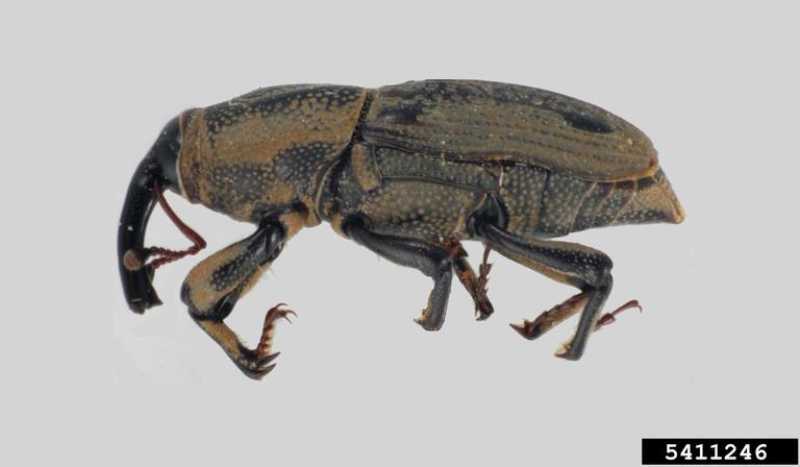
|
Hunting billbugs
Unlike chinch bugs, hunting billbugs are more elusive. Adults are reddish brown-black, ½-inch long, have a curved snout, and are most active during the night and early morning hours. Billbugs are thought to overwinter as adults, and lay eggs in grass stems/leaf sheaths in mid-late spring. Billbug larvae, which unlike annual white grubs are legless, hatch and feed by boring into lower leaf stems. Larvae feed on stolons, which are left characteristically hollowed out in early summer. At this point, zoysia grass will easily pull away from the soil, and symptoms will occur as yellow areas that eventually brown and die out, resembling drought damage.
Lookalikes: Drought, grub damage (see below), chinch bugs (see above)
See “Hunting Billbugs – Emerging Problem for Zoysiagrass in Missouri,” (from Missouri Environment and Garden, July 2, 2012), and “How do I check for insects in my lawn?” and “What insects are problems with zoysia grass lawns in this area?” |
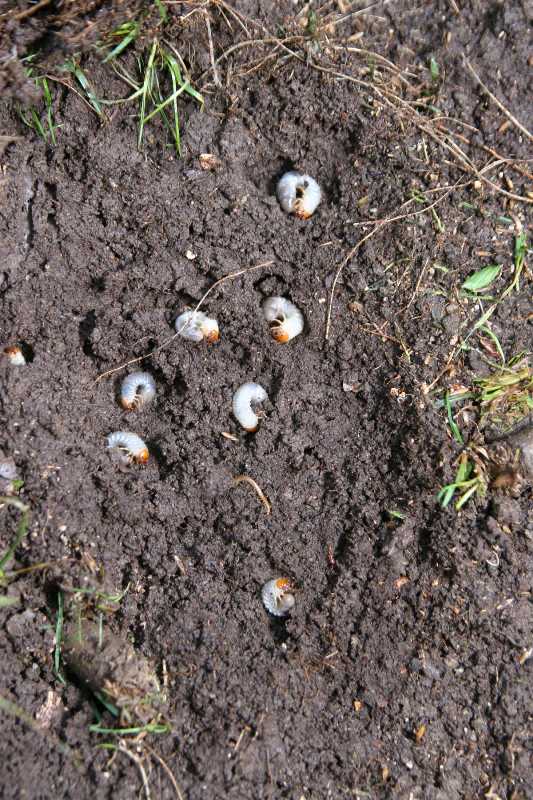

Grass peeled off to reveal grubs |
Grubs
Grubs are the immature form of beetles. They can be a significant problem in irrigated lawns if their population is high. Symptoms of grub problems are gradual thinning and weakening of the lawn followed by small patches of dead or wilting grass even in the presence of adequate soil moisture.Kentucky bluegrass is especially susceptible. Damage is often most evident in August and September. When severe, you can tug at the lawn and easily pull it up like pulling up a piece of carpet. Treatment is advised if 10 or more grubs are found per square foot.
See “Grubs in Lawns” and “What insects are problems with zoysia grass lawns in this area?” |
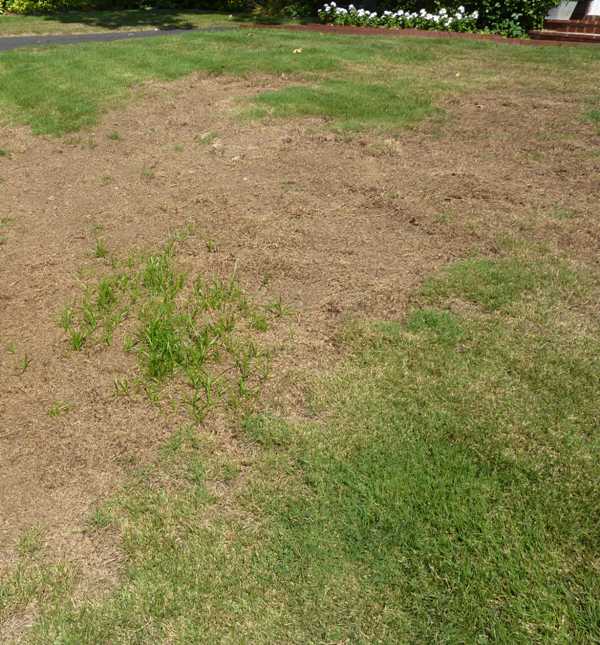
Zoysia grass killed by water collecting in low areas during a wet summer |
Improper watering
Improper watering may result in many problems for a zoysia grass lawn. Zoysia grass is intolerant of standing water and may die out in low areas where water can collect. Although root rots may be obvious, many other problems may not be as obvious. Shallow rooting, increased susceptibility to disease, and attractiveness to grubs are a few of the other problems improper watering can cause.
See “When and how should I water my zoysia grass lawn?” |
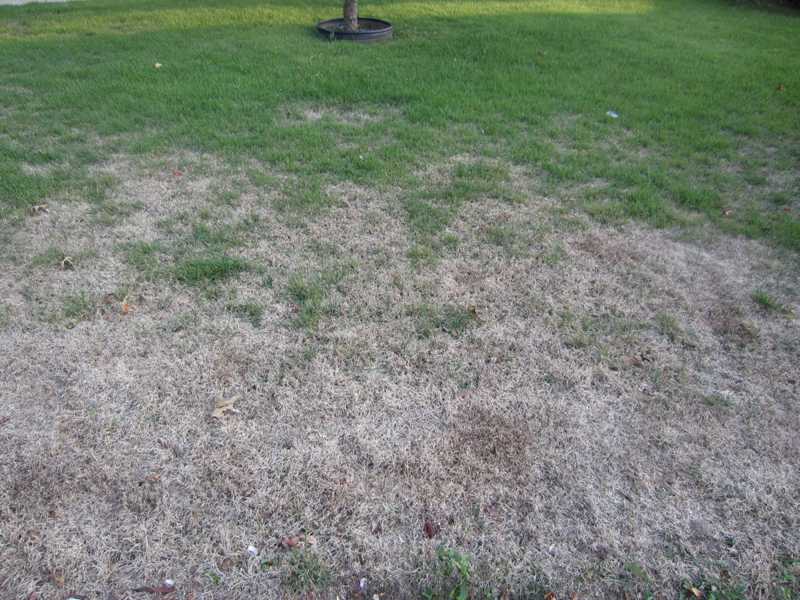
Too much fertilizer applied too early can reduce root growth and drought tolerance |
Improper fertilization
Careless fertilizing can result in brown spots or streaks. Over application of nitrogen in spring results in excessive top growth and poor root development. It can also result in lush top growth that is more susceptible to disease, insects and summer drought. In general, slow release fertilizers are best. Fertilize only when grass is actively growing (late May through August in the St. Louis area).
See “When and how do I fertilize my zoysia grass lawn?” |
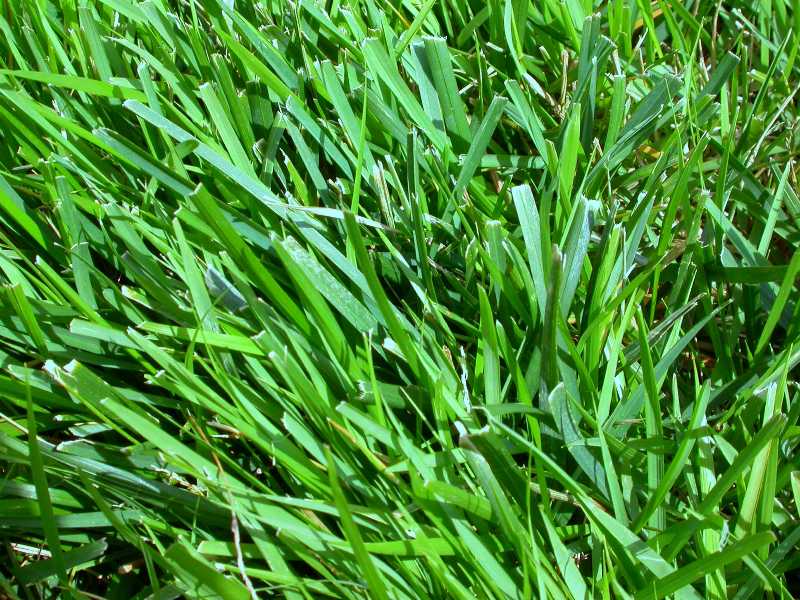
Most homeowners want a lush green lawn, but this is only possible with proper care and nutrition
|
Nutrient deficiencies
Grasses need both macronutrients and micronutrients. Macronutrients are nitrogen, phosphorus potassium, calcium, magnesium and sulfur. There are many micronutrients, including iron. Nitrogen is required in the greatest amounts and is present in all lawn fertilizers and may be all that needs to be applied. In the St. Louis area, soils usually contain sufficient quantities of all macronutrients except nitrogen and sometimes potassium and usually contains all micronutrients, except iron. A deficiency is more likely if grass clippings are routinely bagged or removed. Only a complete soil test can determine if a nutrient deficiency exists.
A basic soil test will measure the soil pH which should be 6.0 to 6.8 for healthy growth. When the soil pH is out of this range the grass will be yellowish green. A basic soil test also measures the percentage of organic matter in the soil, which ideally should be from 5% to 20%. Soils in this area are usually deficient in organic matter. Using organic fertilizers will help remedy this.
See “How do I test my soil?”, “Soil testing and sample collection”, and "When and how do I fertilize my zoysia grass lawn?" |
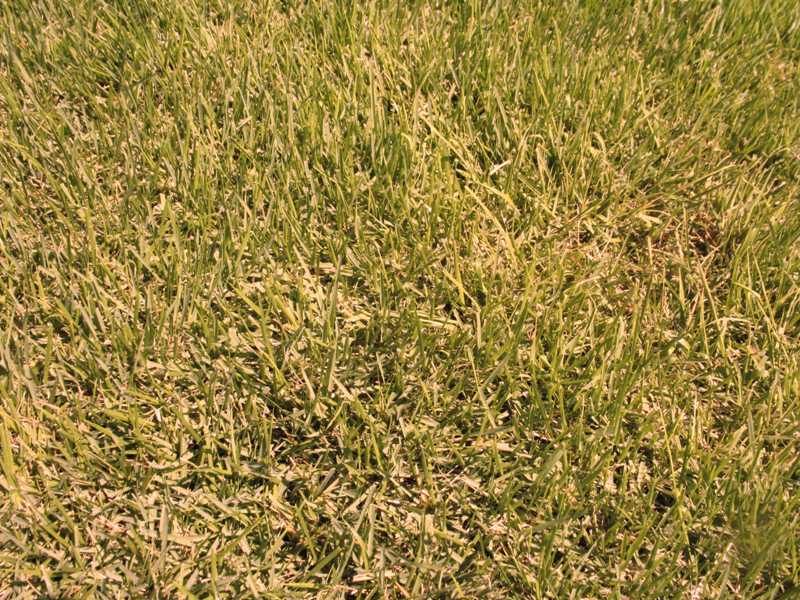
Yellowing of grass blades could indicate a soil pH that is too high (or occasionally too low)
|
Liming
Lawns in the St. Louis area should never be limed unless a soil test indicates that the pH is below 6.0. Lime increases the pH of the soil, making it sweeter or more alkaline. The pH of most soils in the St. Louis area hovers around neutral (7.0) or above, because the soil sits on limestone bedrock and is rich in naturally occurring lime. If more is added unnecessarily, the soil can become too sweet (alkaline) to grow grass and many other plants, including many trees, because plants cannot take up nutrients if the pH is out of range. A pH between 6.0 and 6.5 (slightly acid) is a good compromise for most plants grown in this area.
See “When should I lime my lawn?” |
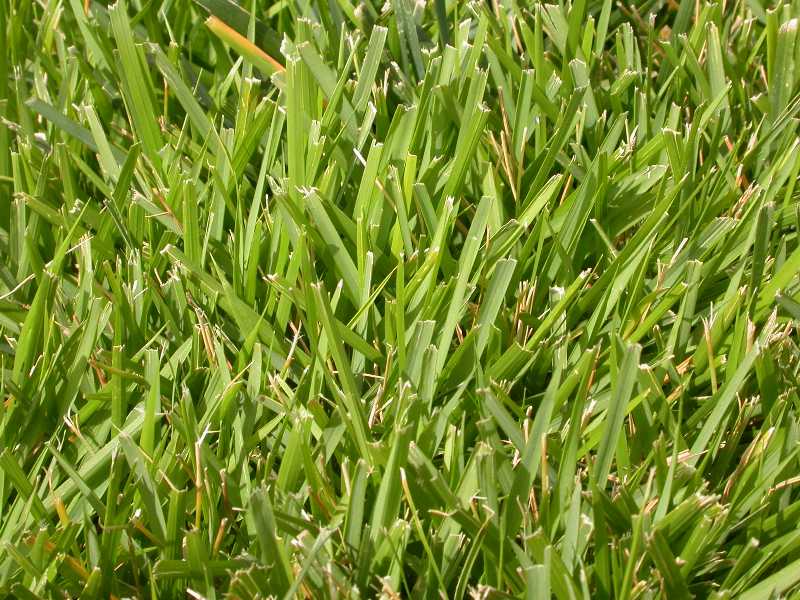
A dull mower blade can result in torn or ragged edges on blades of grass |
Improper mowing
Improper mowing can take many forms from a dull mower blade to scalping. A dull mower blade can give your grass a tan or brownish appearance from the dead, frayed grass blades. Scalping (cutting the grass too short) makes the lawn look brown by removing too much leaf surface and increasing the soil temperate by exposing it to more direct sun. Increased heat and drying can force the grass into dormancy or kill it outright.
See “How often and how high should I mow my zoysia grass lawn?” |
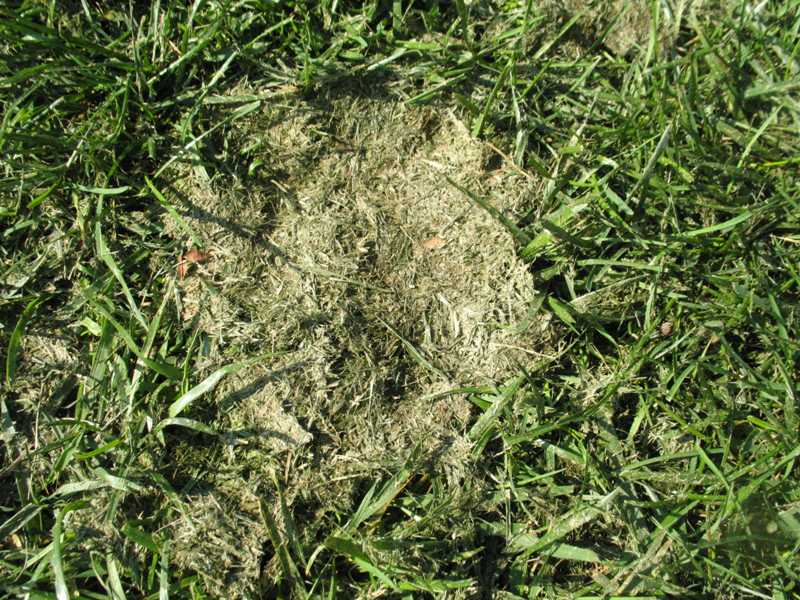
Piles of grass clippings will kill the grass underneath unless removed |
Grass clippings
Grass clippings are not thatch and will not add to the thatch layer. If possible use a mulching mower and leave the grass clippings to decompose. Doing so will substantially reduce the amount of fertilizer needed for a healthy lawn. Bag or remove clippings when clippings pile up and mat.
See "Should I collect my grass clippings?" and “What is lawn thatch and how do I check for it?” |
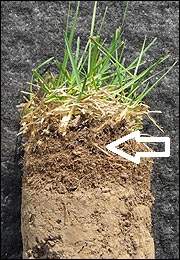
University of Missouri Extension Guide G6708 “Thatch–Enemy of Lawns” |
Thatch
Thatch is a layer of living and dead grass crowns, roots, lower shoots and other organic debris at the soil surface. It appears as a layer of brown, tightly compressed, peat moss-like material. It is not the result of leaving grass clippings on a lawn. It is often a problem in zoysia grass lawns, especially in over-fertilized lawns. A layer thicker than ½ inch can invite insect and disease problems.
See “What is lawn thatch and how do I check for it?” |
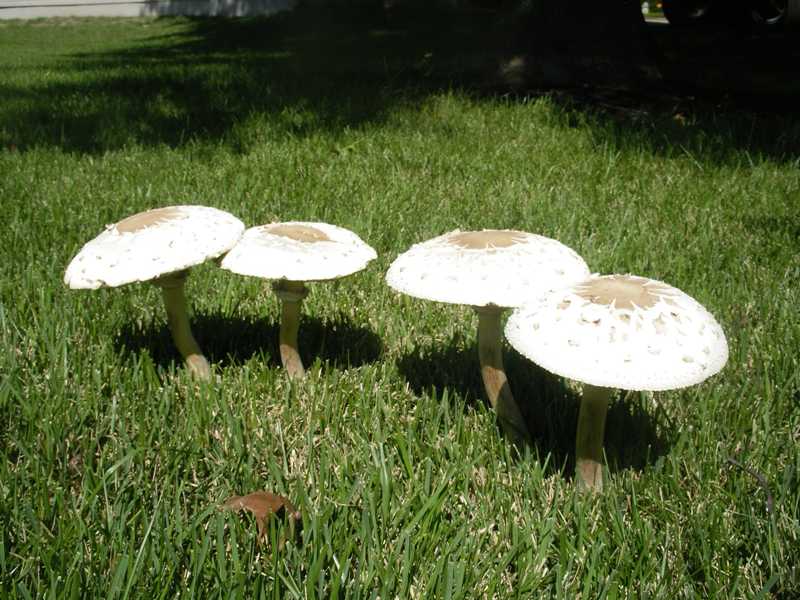 |
Mushrooms in the lawn
Mushrooms are common occurrences during rainy weather. They live off decaying organic matter in the soil, often decaying tree roots, and are not harmful to the lawn. They will disappear as they age, can be collected and composted, knocked down with a rake or hoe, or mowed over with your lawnmower. Never collect and eat unless you are an expert in their identification. |
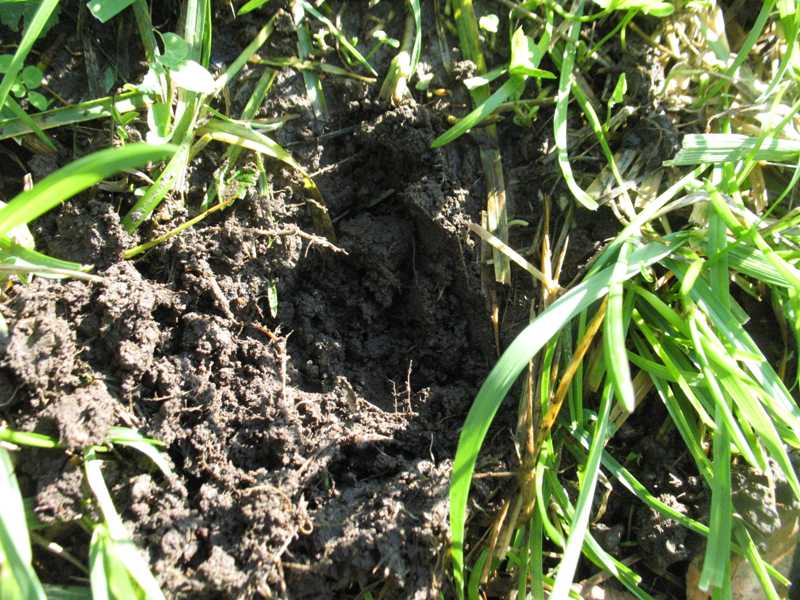
Hole in lawn possibly caused by foraging birds
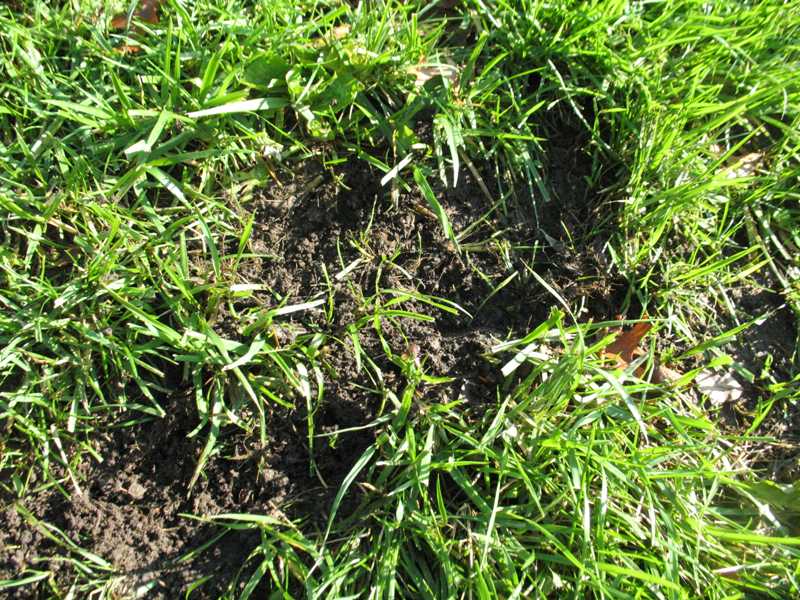
Torn up lawn possibly caused by a foraging animal, such as, a skunk |
Holes or torn up turf in the lawn
Small holes in the lawn can have a number of causes: birds foraging for insects, cicadas emerging from underground, earthworms surfacing, and other harmless insects emerging from the soil. Treatment is generally unwarranted unless a close, proper, and thorough examination reveals high numbers of grubs (discussed above).
Larger holes may be caused by animals, such as, moles, voles, gophers, or rabbits. Torn or scratched up turf usually indicates that an animal has been foraging for insects. Skunks are often the culprits, but other animals may also be to blame, such as, raccoons, squirrels, armidillos or rabbits. A thorough search for grubs (discussed above) is indicated, but the grubs may no longer be present due to the foraging animal.
See "Animals." |
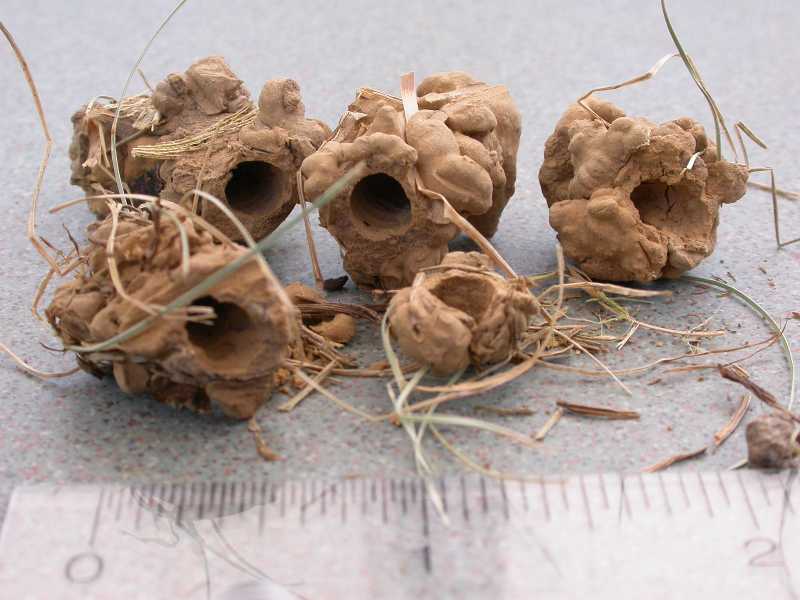 |
Earthworm castings
As earthworms move through the soil they often leave small piles or castings in the lawn. The castings and earthworms are harmless and actually beneficial for the soil as they help aerate and fertilize the lawn.
See "Earthworms."
|
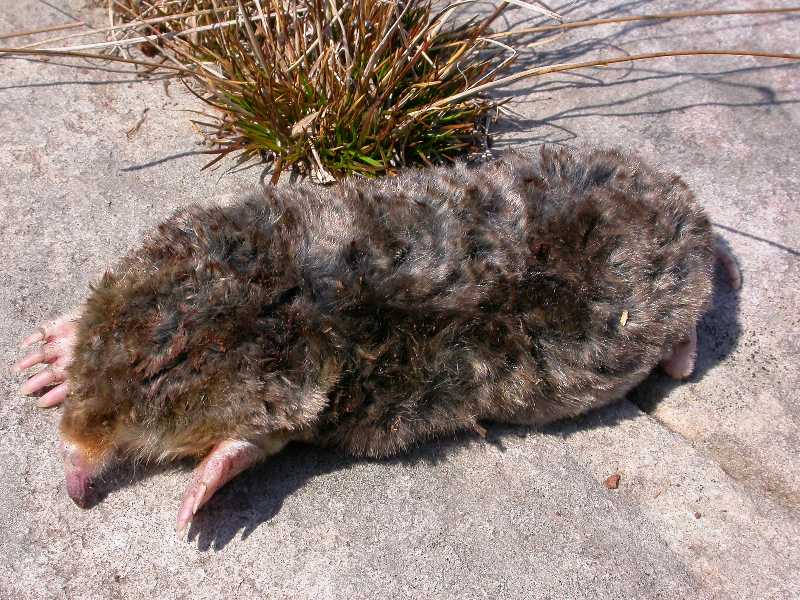
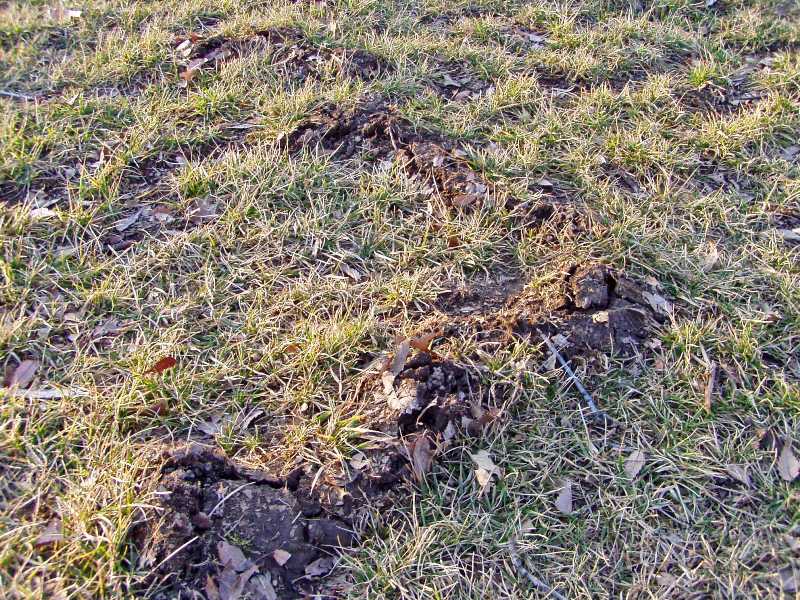
Mole tunnels in lawn |
Moles
Moles are known for unsightly tunneling (bottom image) and uprooting favorite plants. Moles are insectivores, and rarely consume plant material.
See "Moles." |
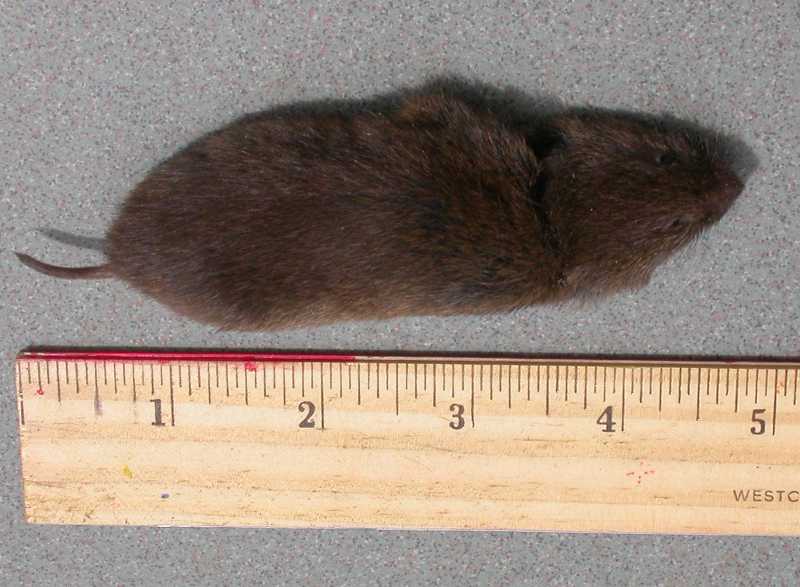
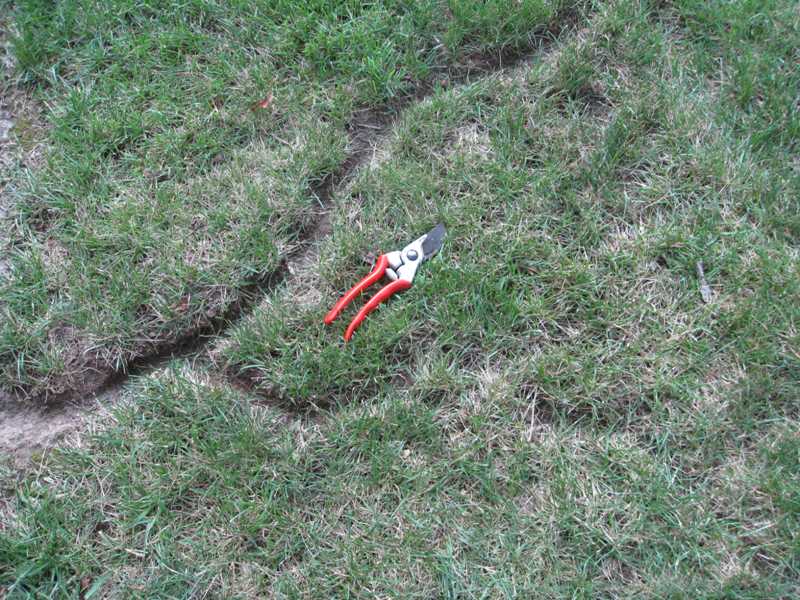
Vole runs are paths of trampled grass |
Voles and mice
Voles, also commonly called meadow mice, are seldom seen though the damage they do to plants is a common sight. They are often responsible for damage attributed to moles. Voles flourish in grassy and weedy areas (including our gardens), creating systems of pathways 1 to 2 inches wide that often are protected by overhanging vegetation (bottom image). Droppings and fresh bits of plants show that a run is being used. Voles or meadow mice also build underground tunnels and may use mole or mouse tunnels as well.
See "Voles and Mice." |
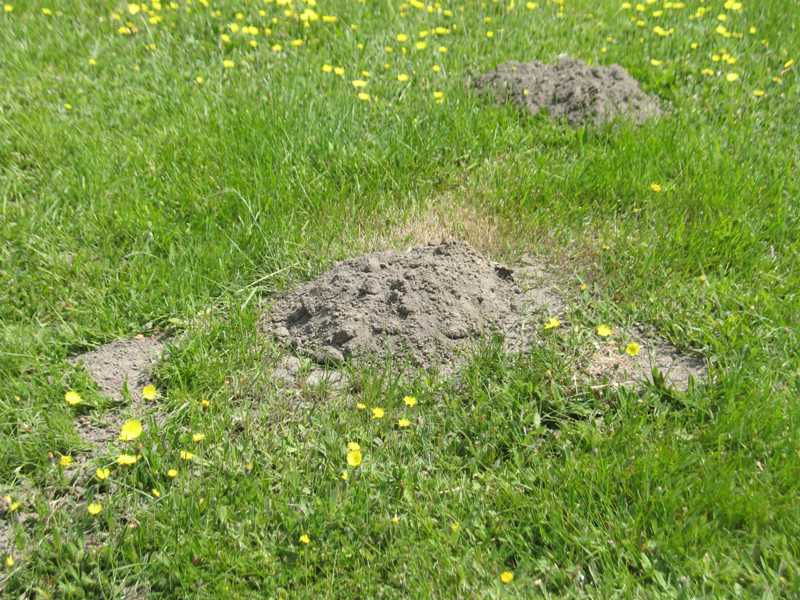
Pocket gopher mound |
Pocket gophers
Pocket gophers are animals that tunnel underground and mound soil in the lawn. Unlike moles, they do not construct surface tunnels. Instead, they construct many mounds of finely sifted soil. They are more of a problem in rural areas than in cities. Besides leaving piles of soil and making mowing difficult, they kill areas of grass and chew the roots and trunks of young trees just below soil level, killing the trees. Problem animals should be trapped using a trap designed for gophers. As they have different feeding habits than moles, mole traps will not catch gophers. |
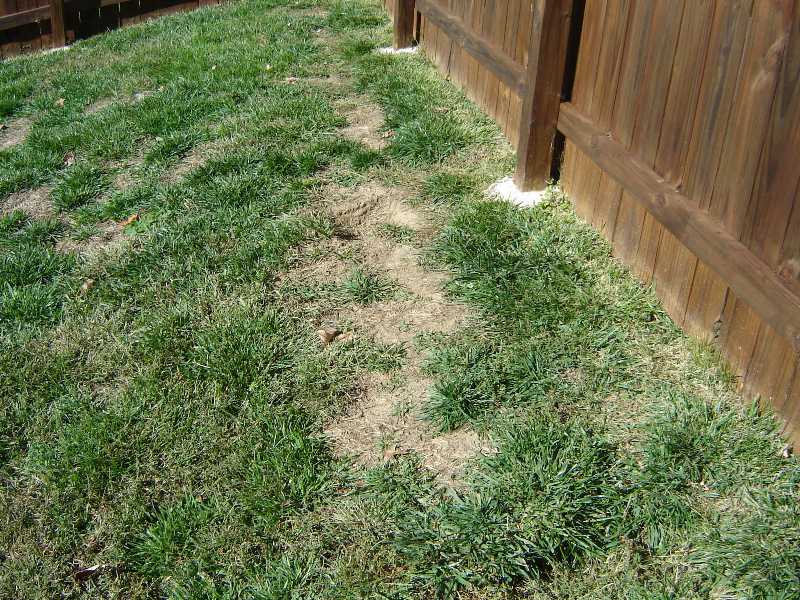
Grass killed from urine spotting and a pacing dog |
Dogs
The most common complaint from dog owners is brown urine spots on the lawn; however, there are also other problems including chewing, digging and run paths.
See "Dogs." |
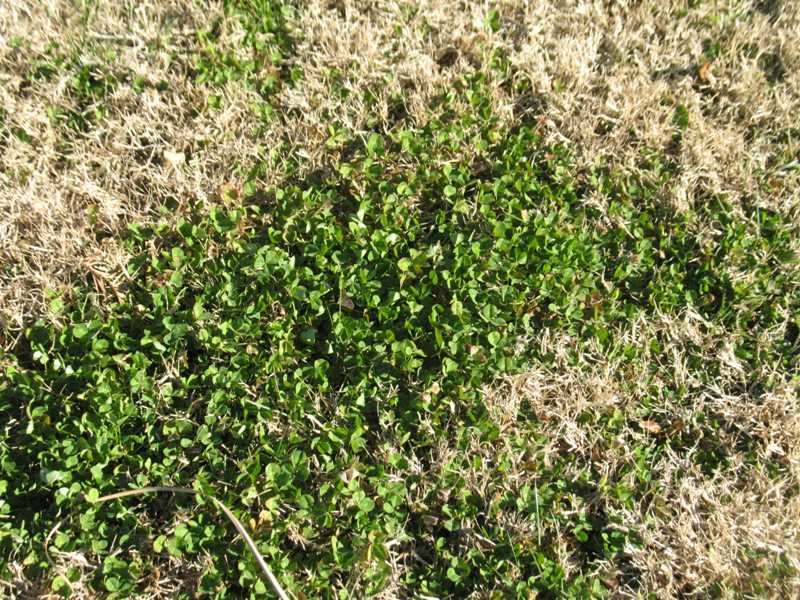
White clover in a zoysia grass lawn
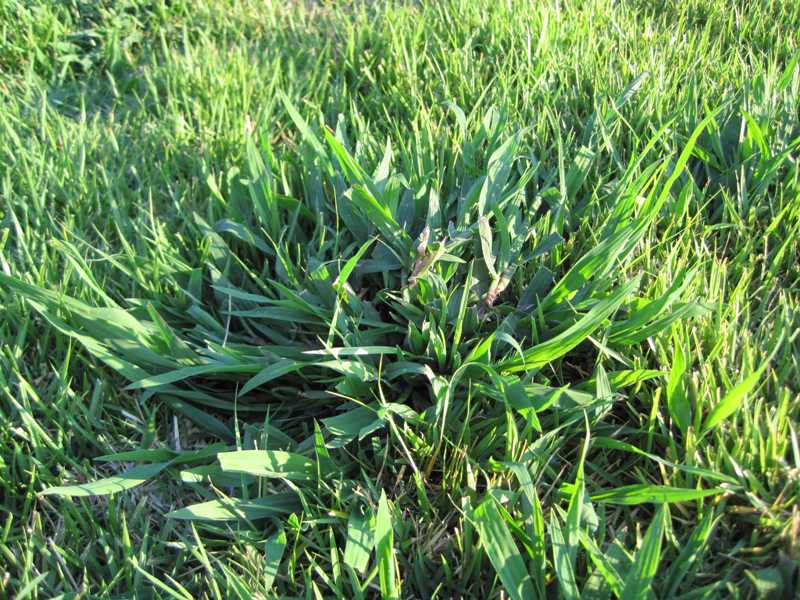
Large crabgrass growing in a zoysia grass lawn |
Weeds
A weed can be any plant that is growing in a lawn, even grass of a species other than the one that is preferred.
See "How do I control weeds in my lawn?" and “Weeds and parasitic plants.” |